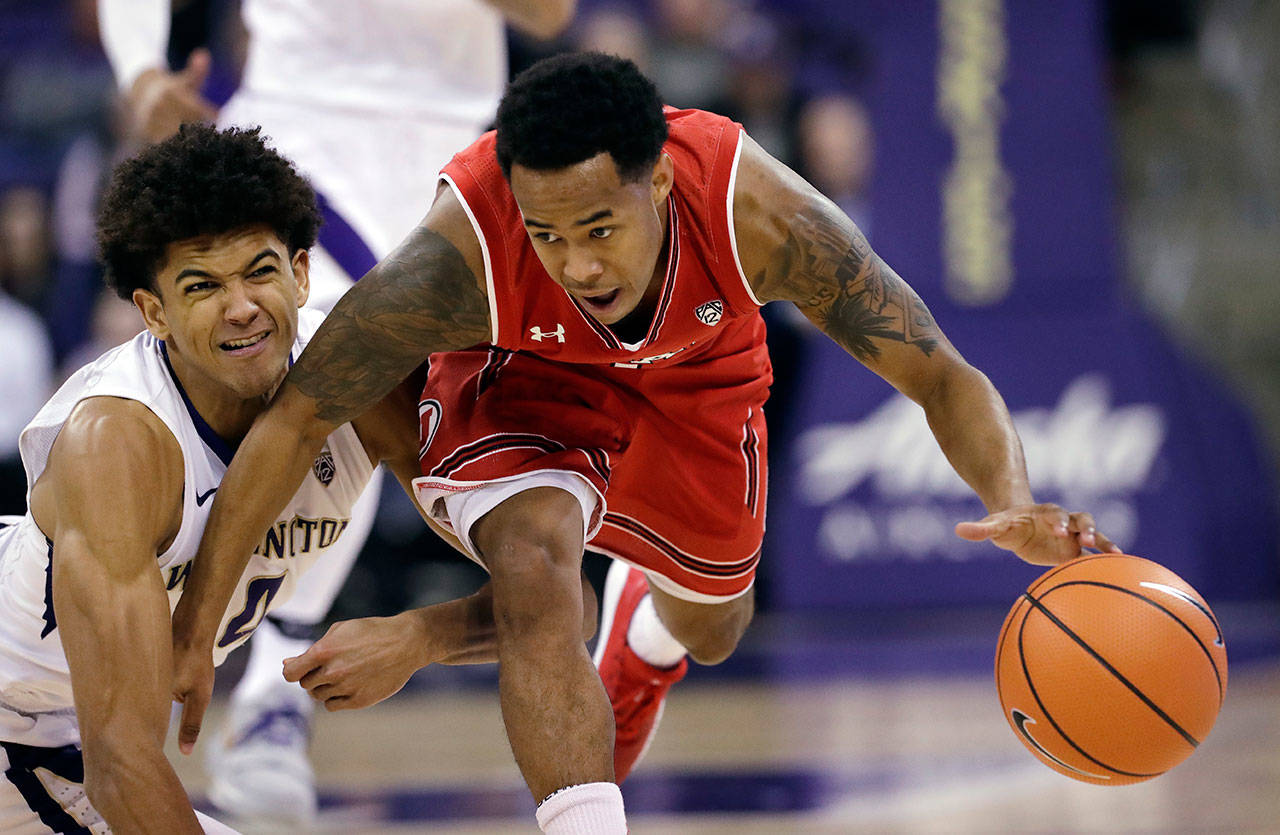SEATTLE — Questions were asked and the five-second pauses that came before the actual answers practically said it all.
There’s something wrong with the Washington Huskies and they know it.
UW, as of two weeks ago, was one of the biggest stories in college basketball. Picked to finish 10th in the Pac-12 following a 9-22 season, first-year head coach Mike Hopkins transformed the Huskies into a surprising winner. At 17-6, they were on a four-game conference winning streak for the first time in years. Consecutive victories over then-No. 25 Arizona State and then-No.9 Arizona — on a last-second 3-pointer — further ignited talk of UW breaking its six-year NCAA Tournament drought.
Much has changed in 14 days. UW (17-9, 7-5 Pac-12) is on a three-game losing streak after dropping games at Oregon, at Oregon State and then at home on Thursday to Utah. Hopkins, in that time, has watched his team falter in many areas between blowing double-digit leads in two of those contests to seeing the much-vaunted 2-3 zone defense get ripped apart in the second half of games.
“Stay together. We gotta be together. We’re not as together as we need to be,” Huskies junior guard David Crisp said after the Utah loss. “We hit adversity, we have to come together closer. It’s not that we’re shying away from each other … we’re not coming together as much as we did before. We gotta get back to that and know we got each other’s back.”
Offense wasn’t an issue during the winning streak. The Huskies were averaging around 75 points while shooting 45 percent from the field and 40 percent from the 3-point line in those four games.
That hasn’t been the case lately. They’re averaging 64 points and that figure is somewhat deceptive given the Huskies scored 94 in a double-overtime loss to the Beavers. Furthermore, the 40 points they scored against the Ducks was both a season low and the lowest figure since 1991. UW shot less than 40 percent from the floor and 30 percent from beyond the arc over the past three games.
It comes at a time when UW’s defense has disappeared. Hopkins’ scheme was tough to figure out. UW kept opponents under 40 percent in the second half of games for four straight contests.
Arizona shot 65.5 percent in the second half but the trend has been highlighted during Washington’s skid. Oregon shot 50 percent. Oregon State went for 57.1 percent. UW initially held Utah to 27.3 percent in the first half only to watch the Utes shoot a blistering 70 percent from the field in the second half.
“You hold a team to 27 percent, you’re doing a good job and then the team comes out and has 70 (percent) in the second,” Hopkins said. “The last two halves we’ve played …. that’s not acceptable. You’re not going to win. Reason why we were winning was because we were the No. 1 defensive team in the league. Seventy percent is not going to get it done.”
Junior guard Matisse Thybulle, who’s fourth nationally with 3.0 steals per game, said the team’s lack of energy is why Utah shot an abnormally high percentage in the second half.
Thybulle was asked if the Huskies struggled to adapt. He responded by saying the team “didn’t play hard.”
Another question was posed to Thybulle. How is playing with energy an issue after 26 games of a 32-game schedule?
Thybulle paused for five seconds before answering.
“I mean, it’s a long season,” Thybulle said. “Fatigue starts to settle in physically and mentally. We gotta be strong and not give into it.”
Hopkins addressed the team’s energy issue by using different rotations. Crisp and Thybulle were two of five players who played more than 25 minutes against the Utes.
At one point, the Huskies put junior Dominic Green on the floor with freshmen Michael Carter III, Nahziah Carter, Jaylen Nowell and Hameir Wright.
UW has largely ran with an eight-to-nine player rotation for most of the season. Junior forward Noah Dickerson along with Crisp, Nowell and Thybulle are averaging more than 26 minutes per game.
Green logs 20 minutes a game while starting center Sam Timmins plays 19.5. Nahziah Carter and Hameir Wright are getting around 14 minutes. Michael Carter III, who missed nearly eight weeks with a fractured wrist, has gradually worked his way into getting more playing time.
Sophomore guard Carlos Johnson, who lifted UW with 10 points in 14 minutes in a win at Washington State earlier in the year, has stayed on the bench.
Johnson, who was held out of only two non-conference games, hasn’t played in nine of UW’s 13 Pac-12 contests.
A year ago, he averaged around 18 minutes per game.
Hopkins said some of his rotations are “still a work in progress.”
“Sometimes, young guys have good practices and you put them in,” Hopkins said. “I thought (Nahziah Carter) could have taken it to the basket a little bit more. And you take it to the basket, you gotta look for kickouts against good defensive teams like Utah.”
Hopkins said he spoke with the team after the game and told them the coaching staff will put together a game plan.
But it falls on the players to have the “energy and togetherness” to enforce it.
“We’ve proven it, we’ve done it,” Hopkins said. “We need to do it for 40 minutes.”
Next on the schedule is Colorado, which was on a three-game winning streak before losing to Washington State on Thursday.
Crisp said the objective moving forward is to look at what happened against Utah and to not make the same mistakes against Colorado.
“It’s a reoccurring theme. It’s a reoccurring pattern,” Crisp said. “It’s nothing that we don’t know. We need to go do it.”
Talk to us
> Give us your news tips.
> Send us a letter to the editor.
> More Herald contact information.

























